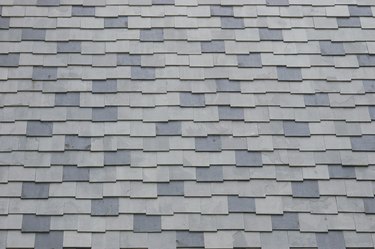
Although roofers commonly cut asphalt shingles on site by scoring them with utility knives, some projects call for more speed or volume, making power saws, such as circular saws or reciprocating saws, handy for cutting asphalt shingles. However, rapidly moving blades melt the asphalt at the cutting point, creating a gummy buildup on the blades' edges. Toothed blades suffer the most from this buildup, so builders typically select blunt, abrasive blades for cutting asphalt shingles, such as diamond blades or masonry cut-off blades. With that in mind, using a power saw for shingle cutting is an unconventional and in most cases unnecessary means. Despite the speed and strength of a power saw, manually operated utility knives remain the standard for cutting asphalt shingles.
Diamond Blades
Video of the Day
Diamond blades' edges are lined with a diamond grit that slices through tough materials such as tile, concrete and asphalt. For roofing applications, diamond blades attach to grinders, portable circular saws and chop saws. Regularly applied to concrete cutting applications, diamond blades easily cut asphalt roofing shingles. If melted asphalt builds up along a diamond blade's edge, you can clean the blade with household cleaning fluids to remove the gum.
Video of the Day
Masonry Cut-Off Blades
Masonry cut-off blades typically consist of mineral grit formed into a disc and bound with resins. These blades attach to several types of saws including grinders, portable circular saws and chop saws. Masonry cut-off blades effectively cut through asphalt shingles, but they quickly wear and become blunt. Despite their short lifespans, masonry cut-off blades are inexpensive compared with diamond blades and are suitable for small to medium-size roofing projects.
Reciprocating Saw Blades
The same types of reciprocating saw blades that cut through metal and masonry can cut through asphalt roofing shingles. Manufacturers label these blades as "masonry" or "metal" blades. In either case, the blades' edges are coated with an abrasive mineral grit similar to the coating on circular-saw diamond blades and masonry cut-off blades. Reciprocating saws are useful for cutting small, curved penetrations through existing roofs, such as plumbing vent access holes or duct protrusions.
Utility Knife Blades
Standard utility knife blades suffice for cutting single shingles. Rather than slice through the entire shingle, roofers simply score the top of a shingle then bend the shingle to snap it along the score. Specialized utility knife blades, called roofing blades, have curved, abrasive edges that easily slice through gritty asphalt shingles. While standard blades are sufficient for small projects, roofing blades withstand prolonged use and create cleaner cuts.